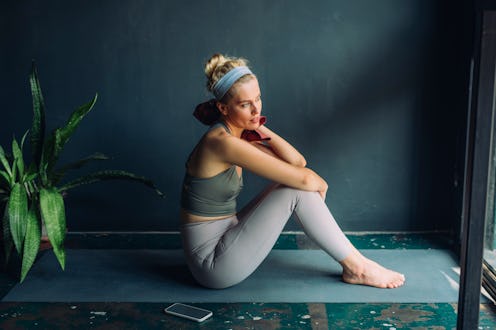Beauty
3 Ways To Prevent Sweat-Induced Pimples, According To Dermatologists
Keep those zits far, far away.

If the advent of a mask-wearing society has taught you anything about your skin, it has be to that there is a definite relationship between sweat and acne. You wear a mask, your face gets sweaty, and your chin breaks out. Or, even in the Before Times — after exercising, you may have noticed bits of breakouts dotting your body. So what’s the deal with sweat pimples?
According to Dr. Hadley King, MD, a board-certified dermatologist, the relationship between perspiration and zits is complicated. “Sweat doesn’t directly cause acne,” she tells Bustle. That said, “as sweat increases, so can sebum production.” Sebum — which is an oily substance that’s secreted from the glands on your face — itself isn’t a cause for distress. In healthy amounts, it keeps your complexion lubricated and prevents moisture from escaping your skin barrier. In excess, though? “An overproduction of sebum can lead to clogged pores and acne,” says King. And this is true for both your body and your face (so that could mean everything from chin pimples to butt zits and chest acne).
The other potential way sweat can mess with your skin is by creating a damp environment, which can lead to a domino effect of irritation and/or acne. “This environment can foster bacterial growth, which may potentially contribute to breakouts as well,” says King. Dr. Morgan Rabach, MD, a dermatologist at LM Medical in New York City, adds that “sweat is what bacteria on the skin like to eat,” which contributes to the aforementioned issue. You can also expect irritation and breakouts when damp skin rubs against other damp skin. “This can cause inflammation of the skin, also known as intertrigo,” says King.
That’s not to say you’ve got to avoid the heat or working out all summer long — just follow these expert-backed tips to prevent those pesky sweat pimples.
We only include products that have been independently selected by Bustle's editorial team. However, we may receive a portion of sales if you purchase a product through a link in this article.
1. Wear Breathable Fabrics
If you know you’re going to be sweating, the first step is wearing light and breathable fabrics like cotton and linen — they’ll not only help your skin, but will also keep you cool, says King. You can also opt for sweat-wicking activewear for your workouts. The idea is to make sure your body stays as dry as possible, even if you’re perspiring.
2. Find A Sweat Powder
You can also keep things dry by reaching for specifically formulated sweat powders, typically found on the shelves as chafe-targeted products. King says these work to absorb the moisture your body produces, which in turn helps keep you breakout-free. Just apply to areas that need it most before you start sweating.
3. Keep Your Pores Clear
Also key? In the summer months, avoid comedogenic — or pore-clogging — ingredients in your beauty routine, says Rabach. These are heavier butters and oils (like coconut oil and shea butter). “I would actually avoid all oil-based products altogether,” she adds, especially if your skin is on the oily or acne-prone side. Keeping your regimen lightweight means you’ll have less of a chance of experiencing sweat-induced breakouts.
It’s equally important to keep your pores clear via the face wash and body wash you’re using. Rabach advises using products containing salicylic acid or alpha-hydroxy acids. “These reduce the amount of natural oil you produce,” she explains. Try cleansing your skin shortly after sweating to reduce the amount of time that dampness has to create zits.
Studies referenced:
Grice, E. (2011). The Skin Microbiome. Natl Rev Microbiol. https://www.ncbi.nlm.nih.gov/pmc/articles/PMC3535073/
Moghimipour, E. (2012). Hydroxy Acids, the Most Widely Used Anti-aging Agents. Jundishapur Journal Of Natural Pharmaceutical Products. https://www.ncbi.nlm.nih.gov/pmc/articles/PMC3941867/
Okoro, E.O. (2016). Study of Facial Sebum Levels and Follicular Red Fluorescence in Patients with Acne Vulgaris in Nigeria. Dermatology. https://www.karger.com/Article/Abstract/439378#
Wang, S. (2013). Effect of Exercise-induced Sweating on facial sebum, stratum corneum hydration, and skin surface pH in normal population. Skin Res Technol. https://pubmed.ncbi.nlm.nih.gov/22891649/
Experts:
Dr. Hadley King, board-certified dermatologist and founder of her eponymous practice.
Dr. Morgan Rabach, MD, a dermatologist at LM Medical in NYC.
This article was originally published on